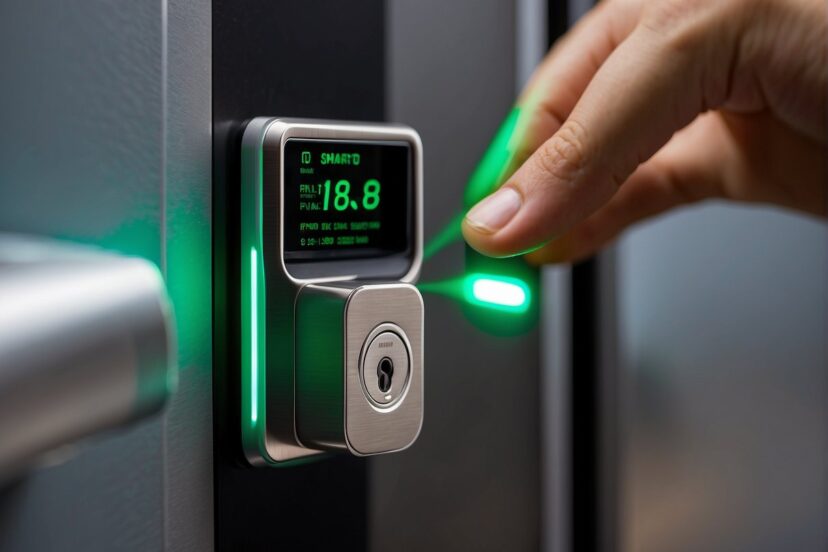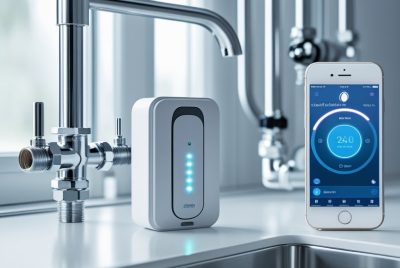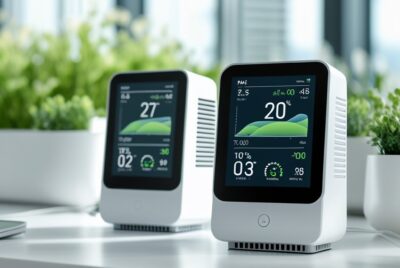Kwikset Smart Lock Reset: Your Step-by-Step Guide
*We may earn a commission for purchases made using our links. Please see our disclosure to learn more.
Kwikset Smart Lock Reset: Your Step-by-Step Guide
The Kwikset Smart Lock reset process is pretty straight forward if you know what to do so let’s jump right in! As a tech enthusiast with a keen interest in home automation, I’m quite familiar with the practicalities and troubleshooting of smart home devices. Kwikset smart locks, a popular choice among homeowners for enhancing the security of their homes, sometimes require a factory reset. A factory reset is often the go-to solution when you are facing operational issues with your smart lock, or when you need to erase all settings and pairings due to moving to a new home or wanting to start fresh.

Resetting a Kwikset smart lock is a relatively straightforward process, although the specific steps can vary depending on the model. Generally, the reset process involves deleting the lock from any associated apps and Bluetooth lists, clearing all user codes, and restoring the lock to its original factory settings. This procedure not only helps resolve technical glitches but also ensures that previous access permissions are completely wiped out, providing a clean slate for reconfiguration according to your current needs.
Understanding Kwikset Smart Lock Models

When it comes to securing your home, choosing the right Kwikset smart lock model is crucial. I’ll guide you through how to identify your Kwikset model, ensuring that you select the system aligned with your needs.
Identifying Your Model
The first step in understanding Kwikset smart locks is identifying which model you own or are interested in. Several popular models include:
- SmartCode Series (910, 913, 914, 916): These are touchpad-enabled deadbolts that offer user code access and vary in their connectivity options, such as Z-Wave or ZigBee.
- Aura & Halo: These smart locks offer Bluetooth or Wi-Fi connectivity respectively, allowing for control via Kwikset app.
- Obsidian: This is a key-free touchscreen deadbolt that emphasizes a sleek, modern design.
- Premis: It’s an Apple HomeKit-enabled smart lock, offering an extra layer of security and the ability to work with Siri voice commands.
- Powerbolt 2: This is a user-friendly electronic deadbolt with a keypad for code entry.
- Kevo: Known for its touch-to-open technology, it’s a Bluetooth-enabled smart lock that works with your smartphone.
- 275 Touchscreen Electronic Deadbolt: A modern electronic deadbolt that offers touchscreen pad access.
Each model is designed for different user needs, from basic keypad entry to advanced connectivity features for integration with home automation systems. To identify your Kwikset smart lock model, locate the model number on the interior assembly of the lock or refer to your product’s original packaging or instruction manual. This will ensure you’re looking up the correct information or seeking out compatible accessories and support.
Remember, identifying the specific features and connectivity of your Kwikset lock is integral for troubleshooting, installation, and usage. Whether you’re looking to upgrade your home security or troubleshoot an existing lock, knowing your exact model is the key to a seamless experience.
Preparing for Reset

Before resetting a Kwikset smart lock, it’s crucial to be prepared with the right tools and to perform initial troubleshooting to ensure a reset is necessary. This preparation can prevent unnecessary resets and ensure the process goes smoothly.
Checklist of Required Tools
- Ruler: For measuring distances if referenced in your smart lock’s manual.
- Phillips-head screwdriver: For any screws that may need to be removed.
- SmartKey tool or paper clip: Most Kwikset locks require this for resetting.
- Battery pack: Ensure you have a fresh set to reinsert post-reset.
Note: Tools like hammers and wood blocks are not typically needed for a reset and should be avoided to prevent damage to the lock.
Initial Troubleshooting
I always recommend that users perform some initial troubleshooting before opting for a reset. This can often resolve simpler issues without needing to reset the lock entirely. Here’s a quick rundown:
- Programming Issues: Revisit the lock’s manual to ensure that you have followed all the programming steps correctly. Issues often arise from missed steps or errors during the programming process.
- Connectivity Troubles: Ensure your lock is not paired with your smartphone or smart home system. If it is, delete the lock from the app and forget the device in your phone’s Bluetooth settings.
- Responsiveness: Check if the lock is responsive to manual key use or to commands through any connected smart technology. Non-responsiveness might indicate a need for a reset.
Carrying out these steps can identify issues that may not require a full reset, thus saving time and maintaining your lock’s settings and codes.
Performing the Reset Process
When I need to transfer ownership or troubleshoot my Kwikset smart lock, I perform a reset. The reset process involves two key procedures: the factory reset to wipe all the settings and the door handing process that ensures the lock operates correctly with the door.
Factory Reset Steps
To initiate a factory reset, I first ensure the lock is disassociated from any connected smart home system or app. Next, the steps I follow are:
- Remove the battery pack.
- Hold the reset button (or Program button on some models) while I reinsert the battery pack.
- Keep the button pressed for about 30 seconds until the lock beeps or flashes red, which confirms the reset.
- After hearing the beep or seeing the light, I release the button, and the factory reset is complete.
This process removes all user codes, the mastercode, and resets the lock to its default settings.
Door Handling Process
Post-reset, I conduct the door handling process to ensure my lock works with the door’s orientation. Here’s how I do it:
- Battery Pack Installation: After the factory reset, I install the battery pack back into the lock.
- Initiate Door Handling: I press and hold the lock button while the door is open.
- Complete the Process: The lock will initiate the door handing process which can include the lock’s bolt moving in and out, determining the correct lock and unlock orientation.
This process ensures my Kwikset smart lock recognizes the proper direction to extend the bolt, securing the door accurately.
Programming and User Codes Management

In managing a Kwikset smart lock, I take great care with programming and user codes. This is a critical aspect of lock security and access management, whether I’m adding new user codes or deleting existing ones. Each code can typically be 4-8 digits in length for personalized security.
Adding New User Codes
To add a new user code, I press the Program button and then enter my desired 4-8 digit code. I press the Lock button to confirm the new code. This simple process allows me to grant access without compromising security. It’s important to ensure that I don’t set obvious codes like 1234, and to manage the number of codes active at any given time to maintain control over access.
- Steps I Follow to Add a New User Code:
- Press the Program button.
- Enter the new user code (4-8 digits).
- Press the Lock button to save the code.
Deleting User Codes
When I need to delete a single user code, my process is straightforward. I press the Program button, and then the Lock button. Next, I enter the user code I want to delete, press the Lock button again, and re-enter the user code to confirm the deletion.
- Steps I Follow to Delete a Single User Code:
- Press the Program button.
- Press the Lock button.
- Enter the user code I wish to remove.
- Press the Lock button.
- Re-enter the user code.
- Press the Lock button for the final confirmation.
If I need to delete all user codes, I will typically need to perform a factory reset or use a mastercode if applicable to my model. During the process of adding or deleting codes, I keep an eye out for a programming timeout, which can occur if I take too long to enter information. To avoid this, I ensure all steps are performed swiftly and accurately.
Smart Lock Integration and Operation

In integrating and operating Kwikset smart locks, I find that seamless connection to smart home systems and the efficient use of the Kwikset app are essential for an optimal user experience.
Connecting to Smart Home Systems
When I first integrate a Kwikset smart lock, such as the Halo Touch, with a smart home system, I ensure it’s compatible with the platform I am using, like Amazon Alexa or Google Assistant. I start by enabling the relevant skill and then pair the lock through the smart home system’s app. In the Bluetooth settings, I locate the lock and connect it, which allows me to unlock the door or check the status LED remotely.
- Steps for Integration:
- Enable the smart home system skill or add the device through the app.
- Pair the lock with the smart home system via Bluetooth settings.
- Confirm the lock is connected by checking the status LED or app confirmation.
Using Kwikset App and eKeys
The Kwikset app is the central hub for managing my lock. I use it to create and revoke eKeys, which are digital keys I can share with family or friends. This feature allows me greater control over who is the lock owner and who can access my home.
- App Management:
- Create eKeys: To give someone access, I generate an eKey in the app and send it to their smartphone.
- Revoke eKeys: If I need to remove access, I can quickly revoke the eKey.
- Event History: The app also provides a log of lock activity, which includes timestamped event history tracking when the door was locked or unlocked.
Moreover, the app interfaces with Bluetooth to allow remote operation even when I am not within standard Bluetooth range, as long as my lock is connected to a compatible smart home network. This ensures I am always in control of my home security.
Frequently Asked Questions
In this section, I’ll address common inquiries regarding the resetting and reprogramming of Kwikset smart locks.
1. How do I perform a factory reset on my Kwikset smart lock?
To execute a factory reset, first ensure your Kwikset smart lock is deleted from the Kwikset app and your phone’s Bluetooth devices. Open the door and keep it unlocked. Press and hold the program button for 30 seconds until you hear a beep. Release and promptly press the program button again to complete the reset.
2. What are the steps to change the code on my Kwikset smart lock?
Change your Kwikset smart lock’s code by pressing the Program button once, followed by the Lock button. Enter the new user code, press the Lock button, and then re-enter the new user code to confirm the change.
3. Why isn’t the factory reset working on my Kwikset smart lock?
If the factory reset isn’t successful, double-check that the door is open and the lock is in the unlocked position. If issues persist, it might be necessary to consult the user manual or contact technical support for further troubleshooting.
4. Where can I find a manual PDF for my Kwikset smart lock?
Manuals for Kwikset smart locks in PDF format are often available on the Kwikset website under their Support or Product Information sections. You can also contact Kwikset customer service for assistance.
5. Is there a specific tool required for resetting my Kwikset smart lock?
Yes, most Kwikset locks require the use of a SmartKey tool or a similar tool like a paper clip to press the program button during the reset process.




